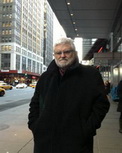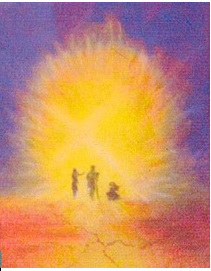 Chris
McDonnell, UK
Chris
McDonnell, UKchristymac733@gmail.com
 Chris
McDonnell, UK
Chris
McDonnell, UK
christymac733@gmail.com
Previous articles by Chris Comments
welcome here
August 1, 2018
The
Transfigured Christ
During
this Summer month of August it is time to remember that this week is
marked by two significant dates from 1945, the first war-time use of
atomic weapons, on the city of Hiroshima on August 6th and then, three
days later, on August 9th, on Nagasaki. The loss of life and the dawn of
the availability of weapons of mass destruction were marked by those
fateful August days. If you look back to the old Roman Missal and read the
Introit for the Mass of the Transfiguration on August 6th you will find
this text, taken from Psalm 76.
"All
the world shone with thy lightning and the troubled earth shook ".
There
is something disconcerting and prophetic in those few words. The argument
that this action ultimately saved lives and brought the war to a rapid
conclusion is challenged more and more.
There
are times in all our lives when an event is transformative, when something
happens that makes a difference; there is a step-change and the person we
were before is radically different from the person we become. There is no
going back.
It
might be meeting someone by chance and experiencing a significant chain of
events that follow. For a mother, the birth of her first child, for a
child the loss of a parent, for two adults, the break-up of a marriage
with all the distrust and feelings of betrayal that are involved. Or it
might be the precious moment when we realised there is a vocation path
that we must follow and the joy of becoming who we presently are, remains
over subsequent years. Each one of us could identify some such turning
point, some significant occasion in our lives, and the older we are, the
more times it might have happened. Of
all the events recorded in the Gospels, the account of Peter, James and
John with the Lord on Mount Tabor, just west of the Sea of Galilee, given
to us by Matthew, stirs the imagination. There, on that rocky outcrop, the
appearance of the man from Nazareth was transformed and momentarily his
three companions were dazzled by the event and covered their faces.
Something of the glory and radiance of God was revealed to them, however
briefly. Did they understand its significance? I doubt it. Did it affect
their lives and their perception of the nature of Jesus? Most certainly it
did. That moment in time was linked with an event that was yet to happen,
the Resurrection of the Lord after his crucifixion at Passover. "Donít
tell anyone just yet", they were told, the significance of such an
event would be lost on those who had yet to walk the journey that led to
it.
Richard
Rohr argues in his book "Falling Upward" that the consequences
of the first part of our lives are only realised in the experience of the
later years, that those years are, in a significant manner, a completion
and an understanding of earlier times. He writes: "The language of
the first half of life and the language of the second half of life are
almost two different vocabularies, known only to those who have been in
both of them".
Just
now and then, we too are transformed, transfigured even, and the dwelling
of God in us is allowed to shine through. Others see it, and are grateful
for our being alongside them. Others feel it, in the gentleness of our
touch or the carefulness of our hug. Others value it when we truly listen
to their words of joy or pain and share with them times of great personal
happiness or the darkness of desolation.
Creative
artists show us vision, in the transformation of materials, whether it is
through paint on canvas, the chiselling of a block of marble or the
exploration of a block of wood. In each form there is something to be
found, some delight to give joy, something to make us think.
In
1961, Barbara Hepworth wrote "I, the sculptor, am the landscape, I am
the form and I am the hollow, the thrust and the contour."
What,
I wonder, was the block of stone like before her hands began their
imaginative transformation of the material?
So
in recognising the enormity of that occasion on the hill of Tabor and its
significance in the lives of three followers of Jesus, in faith, may we
follow their example.
A
beautiful hymn written by John Bell, a member of the Iona Community in
Glasgow called "A Touching Place", has this refrain after each
verse:
"To
the lost Christ shows his face; Letís
leave it there.
END

to the unloved He gives His embrace;
to those who cry in pain or disgrace,
Christ, makes, with His friends, a touching place"
====